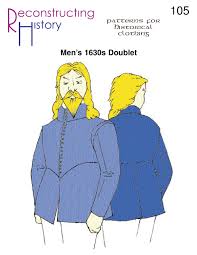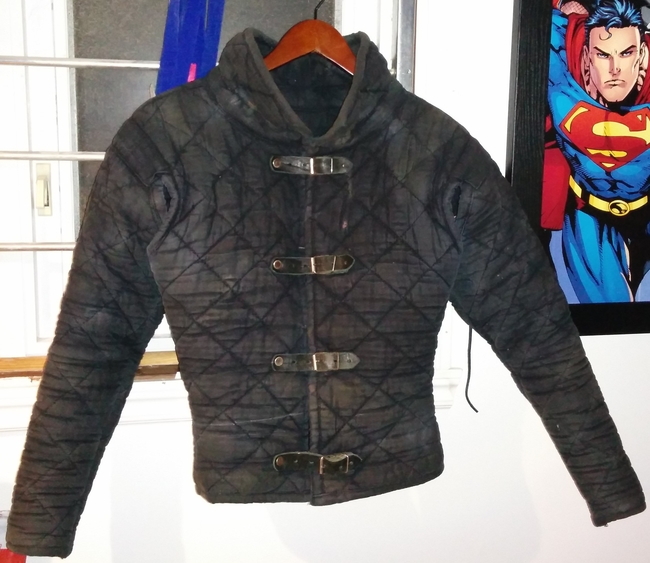| Author |
Message |
|
Danny Nguyen
Location: Montreal Joined: 09 Sep 2015
Posts: 23
|
 Posted: Tue 02 Feb, 2016 2:24 pm Post subject: Buff Coat Sizing Posted: Tue 02 Feb, 2016 2:24 pm Post subject: Buff Coat Sizing |
 |
|
After a while of deciding a padding for armor, I chose to make a Buff Coat. I bought two pieces 3mm thick milled veg tan leather. And decided to use the 1630 doublet pattern from Reconstructing History. However, the pattern sizing selection was design to be made out of cloth, would the measurement change for leather? If so, how much? A size or two?
The design will feature a double layer on the torso, neck and elbow to meet the 1/4'' padding requirement for SCA combat. And a layer of silk lining from my previous idea of a silk gambeson.
 Attachment: 6.84 KB Attachment: 6.84 KB

|
|
  |
 |
|
Radovan Geist
|
 Posted: Tue 02 Feb, 2016 11:17 pm Post subject: Posted: Tue 02 Feb, 2016 11:17 pm Post subject: |
 |
|
Hello Danny,
Strictly speaking, you´ll be making a leather dublet, not a buff coat. But that´s not so important, as long as it meets your purpose. (it has some relevance for what I´ll be writing later, but that´d be probably too technical).
Based on my own experience (I did couple of leather doublets, and now I´m working on a buff coat from a quite thick oil tanned buff leather), sizing depends on the method of stitching. If you´re going to use a butted stitch (with your leather it should be possible), you do not need any seam allowance for the leather part. It´s more difficult to do, and you need to be really precise when cutting and sewing (depending on the method, but your stitches would probably be visible), but for thick leather garments it´s definitely better.
Otherwise, if you´re going to use some classical stitching, you just need to leave at leas 5mm for stitch allowance on each side.
If you´re going to use your garment over another doublet (as you´d do with a buff coat), you have to make it a little bigger (up to 2 cm in width, and 1 cm in length, based on my experience). If you´d wear it just like a normal doublet, then it needs to be fitted well - especially if used for free sparring.
Last but not least, if you use two layers of leather, the upper layer needs to be some 5 mm larger (more in width than in length).
Hope it helps.
If you happen to have the book on 16th-17th C costuming by Janet Arnold (Patterns of Fashion), it has many useful diagrams on the stitching techniques, as well as wonderful patterns. Otherwise you could browse through the webpages of Mr Karl Robinson - for me, he´s an invaluable inspiration: http://www.karlrobinson.co.uk/Galley.html
|
|
  |
 |
|
Danny Nguyen
Location: Montreal Joined: 09 Sep 2015
Posts: 23
|
 Posted: Wed 03 Feb, 2016 6:00 am Post subject: Posted: Wed 03 Feb, 2016 6:00 am Post subject: |
 |
|
Thank you, I will cut the pattern first and modify it to fit. Also I want itas an armor for either heavy combat or cut and thrust. I would need two layers for heavy while only 1 for the other. What would be your recommendation?
I already have a wool gambeson that already met the standards for rattan stick fighting. Should this doublet be made to accommodate for one or both then? Here is the photo.
I could only invest in one or another, either a helmet for heavy or a blade for rapier. This construction would effect my current choice. Thought I leaning more towards the blade for realism and the cost would be 200$-300$ compare to 300$ or more for a heavy helmet. I already started plans modifya fencing mask to a helm with boiled sole bend leather. The rest of the armor is ready. Again, what is your recommendation?
|
|
  |
 |
Martin Moser

|
 Posted: Wed 03 Feb, 2016 9:30 am Post subject: Posted: Wed 03 Feb, 2016 9:30 am Post subject: |
 |
|
Hi Danny,
by coincidence I read a thread last week on a 16/17th cent clothing FB group and multiple persons gave the feedback that they found the RH patterns not working for them for various reasons. I suggest to make a mockup in cheap, somewhat heavy cloth first to make sure not to waste a lot of money in leather in case.
I can only second Radovan's suggestion to get Janet Arnold's book and look at the options and ideas it might give you. A lot to learn about techniques employed etc. there as well.
Good luck,
Martin
Cheers,
Martin
https://www.facebook.com/leatherworkthroughtheages/
|
|
   |
 |
|
Jeffrey Faulk
|
 Posted: Wed 03 Feb, 2016 2:27 pm Post subject: Posted: Wed 03 Feb, 2016 2:27 pm Post subject: |
 |
|
|
I will second the suggestion to do a mock-up. Sheets of newspaper taped together to make large sections will work fine, albeit being somewhat fragile. Once you have a rough pattern in mind, consider a cheap cotton canvas tarpaulin (readily available at Home Depot, Lowe's, Ace, any large hardware store really) for developing it further. Once you have a pattern, a newspaper mock-up, and a canvas version, you should have a pretty good idea of how to make the proper leather coat.
|
|
  |
 |
|
Danny Nguyen
Location: Montreal Joined: 09 Sep 2015
Posts: 23
|
 Posted: Wed 03 Feb, 2016 8:03 pm Post subject: Posted: Wed 03 Feb, 2016 8:03 pm Post subject: |
 |
|
Sorry about the previous post, the file size was too large, here is it now. Could I use the basic torso template from my gambeson as it is custom fitted? How would I butt stitch joints if the the body is composed of two layers?
Should it even be made from two layers? As the gambeson is still serviceable, thus should the coat be a separate protection for cut and thrust or as a complete replacement for everything?
 Attachment: 248.03 KB Attachment: 248.03 KB

|
|
  |
 |
|
Radovan Geist
|
 Posted: Thu 04 Feb, 2016 11:19 pm Post subject: Posted: Thu 04 Feb, 2016 11:19 pm Post subject: |
 |
|
Hi Danny, I can only advise on some of your questions, a decision between a heavy combat kit, and a one for cut-and-thrust depends on your personal preferences.
I would personally make the coat from one layer, and use some protective undergarment - for example your gambeson. If you make it from two layers, you´d need to stitch it separately, and than join one on the other (for example with some decorative stitching).
If you´d use your gambeson as a template for torso, I´d recommend some modifications, especially moving the waist-line much higher, just beneath your ribs. First, for historical authenticity (if that´s important for you), second for flexibility and comfort in movement.
|
|
  |
 |
|
Mark Griffin
Location: The Welsh Marches, in the hills above Newtown, Powys. Joined: 28 Dec 2006
Posts: 802
|
 Posted: Fri 05 Feb, 2016 3:15 am Post subject: Posted: Fri 05 Feb, 2016 3:15 am Post subject: |
 |
|
That gambeson wouldn't work for the buff coat, the seams are not in the right place and the cut isn't right. I'd be making a new toil and adapting. Then make ply copies of your final results to keep for later.
Currently working on projects ranging from Elizabethan pageants to a WW1 Tank, Victorian fairgrounds 1066 events and more. Oh and we joust loads!.. We run over 250 events for English Heritage each year plus many others for Historic Royal Palaces, Historic Scotland, the National Trust and more. If you live in the UK and are interested in working for us just drop us a line with a cv.
|
|
  |
 |
|
Danny Nguyen
Location: Montreal Joined: 09 Sep 2015
Posts: 23
|
 Posted: Fri 05 Feb, 2016 10:06 am Post subject: Posted: Fri 05 Feb, 2016 10:06 am Post subject: |
 |
|
|
Simply, what would be more historical for sport as well as thickness? And would it be possible to glue the two layers together? If not, would it be better to make a one layer sleeveless doublet and one complete buff coat over it?
|
|
  |
 |
|
Radovan Geist
|
 Posted: Sun 07 Feb, 2016 10:59 pm Post subject: Posted: Sun 07 Feb, 2016 10:59 pm Post subject: |
 |
|
I would not try to glue it. Depending on the type of glue you´d use, you could end up with something too rigid to be used for fencing.
Having two separate pieces, one sleeveless, is a good idea. I that case I would wear the sleeveless piece over the coat. Based on my experience, it´s more comfortable and allows better movement (for free fencing, I use heavy woolen doublet, lined with linen, and a padded jerkin over it).
|
|
  |
 |
|
Danny Nguyen
Location: Montreal Joined: 09 Sep 2015
Posts: 23
|
 Posted: Mon 08 Feb, 2016 4:38 am Post subject: Posted: Mon 08 Feb, 2016 4:38 am Post subject: |
 |
|
|
Thank you, so I will one layer for fencing and add a second for armor. I will continue this on a new buff coat WIP thread.
|
|
  |
 |
|
|
You cannot post new topics in this forum
You cannot reply to topics in this forum
You cannot edit your posts in this forum
You cannot delete your posts in this forum
You cannot vote in polls in this forum
You cannot attach files in this forum
You can download files in this forum
|
All contents © Copyright 2003-2024 myArmoury.com — All rights reserved
Discussion forums powered by phpBB © The phpBB Group
Switch to the Basic Low-bandwidth Version of the forum
|

